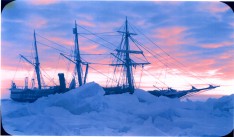Mush! To The Movies! - South

South (1919) by Frank Hurley
The Velaslavasay Panorama & Los Angeles Filmforum Present
Mush! To The Movies! : A Polar Film Club
South (1919)
Preceded by: An Illustrated Lecture by Charles Hood
Friday, June 26th, 2015 7:30pm
Tickets Available at http://mushsouth.brownpapertickets.com
$10 General Admission
Free Tickets for Panorama and Filmforum Members with advance RSVP to event@panoramaonview.org
Mush! To The Movies! Is a selection of films spanning over 90 years of glacial activity and handpicked by Los Angeles Filmforum's Director Adam Hyman and Sara Velas & Ruby Carlson of The Velaslavasay Panorama. The series will feature six events with free popcorn offered to all in the Nova Tuskhut, an installation of the only Arctic Trading Post on the North American Continent, located on the grounds of the Velaslavasay Panorama. Attendees will be given a unique souvenir Polar Passport and those who attend all six screenings will receive a surprise gift and a chance to win a night’s stay in The Nova Tuskhut!
South Preceded By:
The Artists, Writers, Photographers, Scuba Divers, German Directors, and Visiting Astronauts of NSF's Antarctica Program - An Illustrated Lecture by Charles Hood
Werner Herzog's cameraman Henry Kaiser has created evocative short films about the otherworldly seabed beneath Antarctic ice. We will view excerpts of some of Kaiser’s films combined with a talk by the poet Charles Hood. The National Science Foundation runs a very competitive, and somewhat misunderstood, Artists and Writers program; Hood will talk about the origins of that program, review some of the best work by previous A&W residents, and share perspectives on how the polar communities view Shackleton and other historic explorers in the present day.
About Charles Hood:
A Research Fellow at the Center for Art + Environment, Charles Hood has been an Artist in Residence with the National Science Foundation, the Center for Land Use Interpretation, the Playa Arts Foundation, and the Annenberg Beach House, Santa Monica. His book about Antarctica, South x South, won the Hollis Summers Poetry Prize. He has seen over 5,000 species of birds in the wild, eaten live ants in the Amazon, survived bubonic plague, been charged by a musk ox, and was lost in a whiteout in Tibet. His most recent publication surveys the urban forests of Los Angeles for Heyday's LAtitudes project.
Thank you to Milestone Films for South.
Remaining Mush! To The Movies! Screenings Include:
Saturday, July 18th, 2015 7:30pm - Journals of Knud Rasmussen (2006)
Saturday, August 15th, 2015 7:30pm - Eskimo (1933)
South, by Frank Hurley
South
UK, 1919, 81 min., Restored Digital Projection
Directed by Sir Ernest Shackleton & Frank Hurley
Silent with score
Restored by the British Film Institute, this is the original film recounting one of the most revered expeditions in history - the 1914-16 unsuccessful attempt of Sir Ernest Shackleton and his men to cross the Antarctic continent from one side to the other via the South Pole. Fully aware by this time of the necessary lectures for fundraising to make any polar expedition, and the value of a film, Shackleton hired Frank Hurley to document the trip. The voyage was ill-fated almost from the start, as Shackleton’s ship Endurance got caught in the Antarctic ice and sank to the ocean depths. The epic struggle for survival that followed is perhaps the classic heroic adventure tale, involving open sea voyages in small boats, near starvation, and a crossing by foot over unmapped regions of a remote island. Just fifteen years ago, new best-selling books and films popularized the journey, and Shackleton is still used as a educational model for leadership skills. Shackleton remarkably did not lose a man under his command, although such couldn’t be said for the men that his expedition dropped off on the other side of Antarctica to leave depots for the expedition teams that would ultimately never arrive. Hurley’s still photos of the trip are remarkable, but in one legendary act, at the time when the open boat journey was to begin, Shackleton and Hurley destroyed a large number of plates, selecting only the best, as weight was limited. Nonetheless, in the end, Hurley created a remarkable, meditative film on the awe-inspiring power of nature and the heroic and perhaps foolish struggle of humans to journey in the Earth’s harshest climate.
This restored version of the film has been constructed by the BFI National Archive from a wide range of materials. The BFI National Archive has applied its own tinting and toning to match the original prints, and has produced this handsome and richly colored testament to a remarkable episode in the history of exploration. Thank you to Milestone Films, the American distributor of this restoration.
